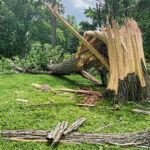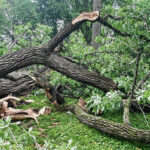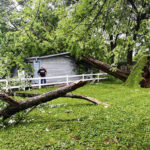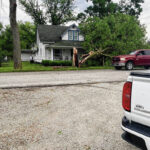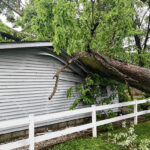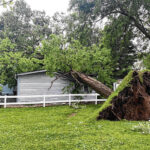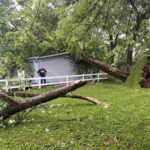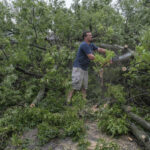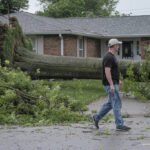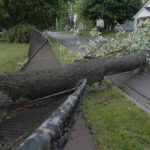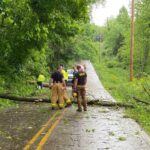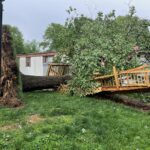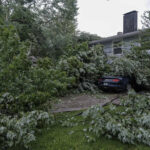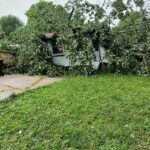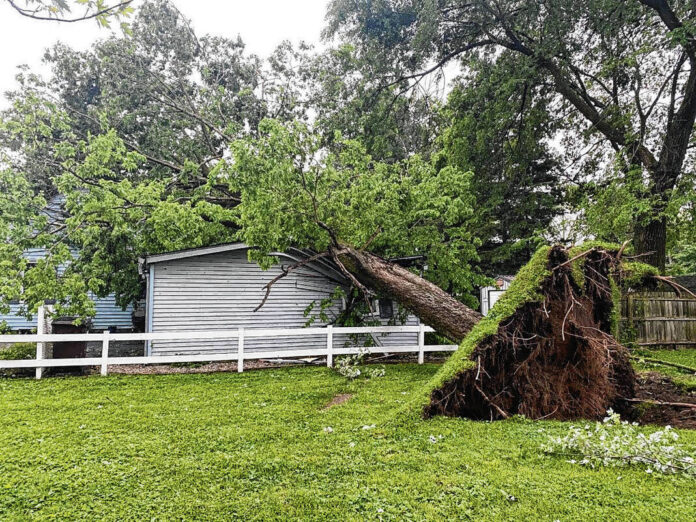
Photo provided A tree is shown across the top of a garage owned by Kim and Rick Hampton in Taylorsville following Saturday’s severe storms.
Duke Energy and Bartholomew County REMC workers continued their efforts to restore power to thousands of Bartholomew County residents as hard-hit Taylorsville set about a massive cleanup effort from the fast-moving and brutal Saturday thunderstorm.
About 6,600 Columbus area residents were still without power Sunday afternoon, down from a now estimated 23,000 Duke Energy customers who lost power Saturday throughout the county, said Chip Orben, Duke spokesman.
About 600 of those customers who had been without power for 24 hours were in an area from California to Washington streets and up to National Road, including the Donner Park area.
Estimates were power could be restored to that area Sunday night, although Orben said three spans of primary lines were down in the area, which was causing the extra time needed to restore power.
There was damage in Donner Park, known for its huge trees, and walkers and joggers were stopping there to take photos of splintered tree trunks on Sunday.
Throughout the state, Duke Energy has restored power to 43,000 customers. Two waves of storms beginning Saturday broke numerous utility poles and brought down power lines, causing power outages for more than 57,000 customers, primarily in southern Indiana.
To speed power restoration for the approximately 14,000 that remain out of service as of 11 a.m. Sunday, Duke Energy has moved employees and contractors from its Ohio and Northern Indiana service area to supplement local crews in southern Indiana. The areas most impacted include Bartholomew, Shelby, Monroe, Morgan, Crawford, Brown and Decatur counties.
Power is expected to be restored to most customers by midnight, but in the hardest hit areas around Columbus, restoration may continue into Monday, Orben said.
Bartholomew County REMC said after the storm exited the county just after 4 p.m. Saturday, about 2,300 members were without power, scattered across the northern part of the county, the largest being an outage to our Rocky Ford metering point with 650 members out. That was restored 20 minutes after midnight and was due to a tree on a transmission line.
REMC had 850 members still out of power on Sunday, resulting from extensive damage to poles and lines, officials said. Work continued Sunday afternoon to assist those customers.
In Taylorsville, residents awoke to a day of cleanup from downed trees and blown transformers, with some suspecting that a tornado may have traveled through the area.
Kim and Rick Hampton, who live on what was formerly Tannehill Road, were just getting ready to go to a birthday party at Donner Center in Columbus at 4 p.m. Saturday when they heard a nearby transformer blow.
After getting their dog into the house, they looked outside again and saw the neighbor’s roof shingles being blown straight up off the roof and their trash can careening across the yard.
“I told Rick we needed to get to the basement,” she said, and just as they were downstairs, she said they heard a large tree fall on their garage.
“It sounded like something heavy shifted on the house,” she said.
The tree hit the side of the garage, caving in the entire top with a support beam falling on a car and truck inside the structure, she said. “For sure, it’s a tornado,” she said.
The couple, who have lived there for 35 years, was not injured. “God was protecting us as always,” she said. “But nothing like this has ever happened before.”
Taylorsville and the northern tier of Bartholomew County, along with the northern side of Columbus, took the brunt of the storm, said Bartholomew County Sheriff Matt Myers, who was driving through that area Sunday morning.
The Tudor addition and Paula Drive in Taylorsville, along with the former Tannehill Road area were particularly hard-hit, he said.
There are numerous downed power lines and blown transformers throughout Taylorsville, and Duke employees and the National Weather Service were in the area on Sunday, he said.
“This is probably one of the worst storms I’ve seen in 30 years of law enforcement,” Myers said.
Shannan Cooke, Bartholomew County Emergency Management director, agreed with Myers that the Taylorsville area and the northern part of the county took the hardest hits from the storm, and acknowledged that a good section of Columbus lost power for a significant amount of time.
Straight line winds were most likely the cause of the damage, she said, with some estimates being at 70 mph to 80 mph during the storm.
The National Weather Service issued a severe thunderstorm watch at 1:53 p.m. Saturday, followed by a severe thunderstorm warning at 3:53 p.m., Cooke said.
What happened next is still being investigated, but Cooke said the National Weather Service issued a tornado warning for southern Shelby County and Rush County right around 4 p.m.
For an unknown reason, just after 4 p.m., a notification went out by email for a tornado warning for Bartholomew County, although the National Weather Service has confirmed it did not issue a tornado warning for the county, Cooke said.
Residents have saved the message on their phones as verification to show to Cooke, she said.
Since Bartholomew County did not have a tornado “warning,” the sirens did not automatically activate, she said. If the National Weather Service issues a tornado warning for the county, the Everbridge system sends out a notice to subscribers and then sets off the sirens, she said.
“The question is, why did the Everbridge system send a message out for Bartholomew County and German Township (a tornado warning),” Cooke said. “Where did that come from?”
Cooke reminded residents that tornado sirens, which are placed throughout the county and in Columbus, are only set off when a tornado warning is issued by the National Weather Service, or a tornado is spotted in the county. There are no reports of a funnel cloud being spotted in Bartholomew County so far.
In earlier years, the sirens were set off during severe thunderstorms, which officials said led to complacency about seeking shelter when they were going off so often. “We were getting concerned that people would start ignoring it,” she said.
Cooke said local residents need to remember the sirens are warnings for those who are outdoors when a tornado warning has been issued. Using a weather app on a phone, listening to a weather radio or subscribing to Everbridge are ways to receive a notification when a tornado warning is issued by the weather service, she said.
Myers said he will work with Cooke, the emergency 911 center that is dispatch for city and county first responders and the 911 board to determine what happened with the tornado warning message and why the process unfolded as it did.
Julie McClure | The Republic A massive tree which split and fell over is shown in Donner Park on Sunday, May 22, 2022.
Julie McClure | The Republic Tree damage is shown in Donner Park on Sunday, May 22, 2022.
Photo provided A tree is shown across the top of a garage owned by Kim and Rick Hampton in Taylorsville following Saturday’s severe storms.
Photo provided. A tree is shown on top of a home at Walnut Street and Tannehill Road in Taylorsville.
Photo provided A tree is shown across the top of a garage owned by Kim and Rick Hampton in Taylorsville following Saturday’s severe storms.
Photo provided A tree is shown across the top of a garage owned by Kim and Rick Hampton in Taylorsville following Saturday’s severe storms.
Mike Wolanin | The Republic Good samaritan Paul White uses his chain saw to help the Bultman’s and their friends clear a tree blocking the Bultman’s daughter’s home on 31st Street after severe thunders storms caused damage across Columbus, Ind., Saturday, May 21, 2022.
Mike Wolanin | The Republic Good Samaritan Paul White uses his chain saw to help the Bultman’s and their friends clear a tree blocking the Bultman’s daughter’s home on 31st Street after severe thunders storms caused damage across Columbus, Ind., Saturday, May 21, 2022.
Mike Wolanin | The Republic Bryant Bultman walks past a downed tree in front of his daughter’s home on 31st Street after severe thunders storms caused damage across Columbus, Ind., Saturday, May 21, 2022.
Mike Wolanin | The Republic A tree blocks the 17th Street after severe thunders storms caused damage across Columbus, Ind., Saturday, May 21, 2022.
Photo provided Bartholomew County Sheriff deputies work to clear a roadway after Saturday’s storm.
Photo provided Trees down on a mobile home in the Taylorsville area are shown.
Mike Wolanin | The Republic A car and home on 31st Street are covered by downed tree branches after severe thunders storms caused damage across Columbus, Ind., Saturday, May 21, 2022.
Photo provided Trees down on a mobile home in the Taylorsville area are shown.

